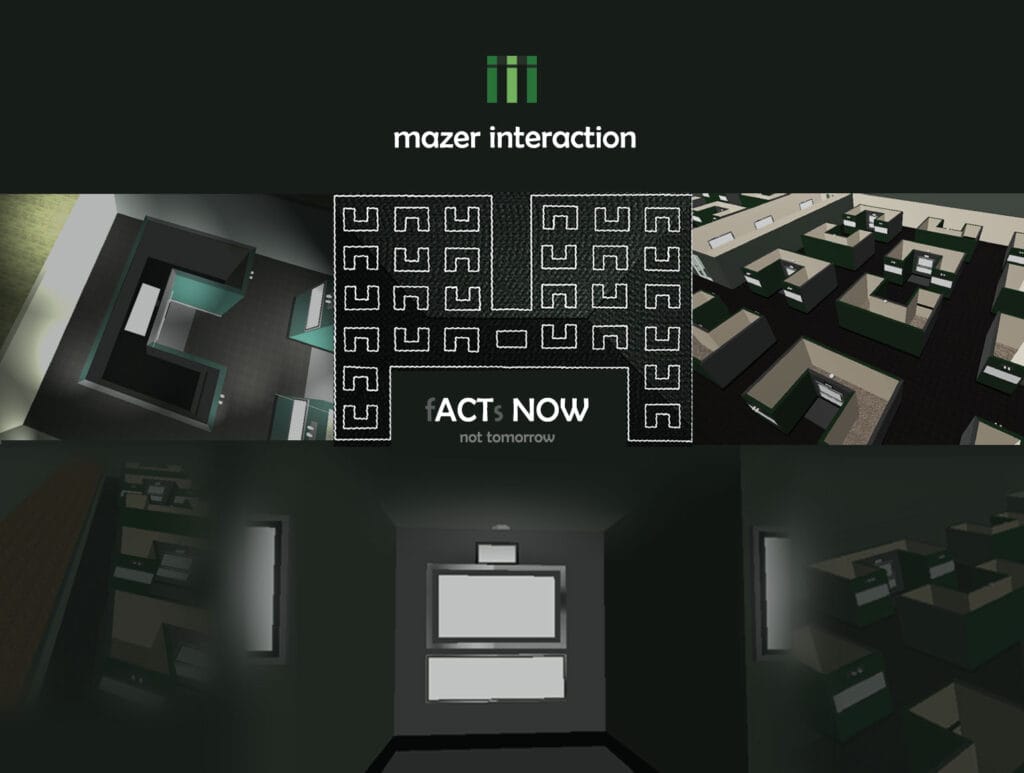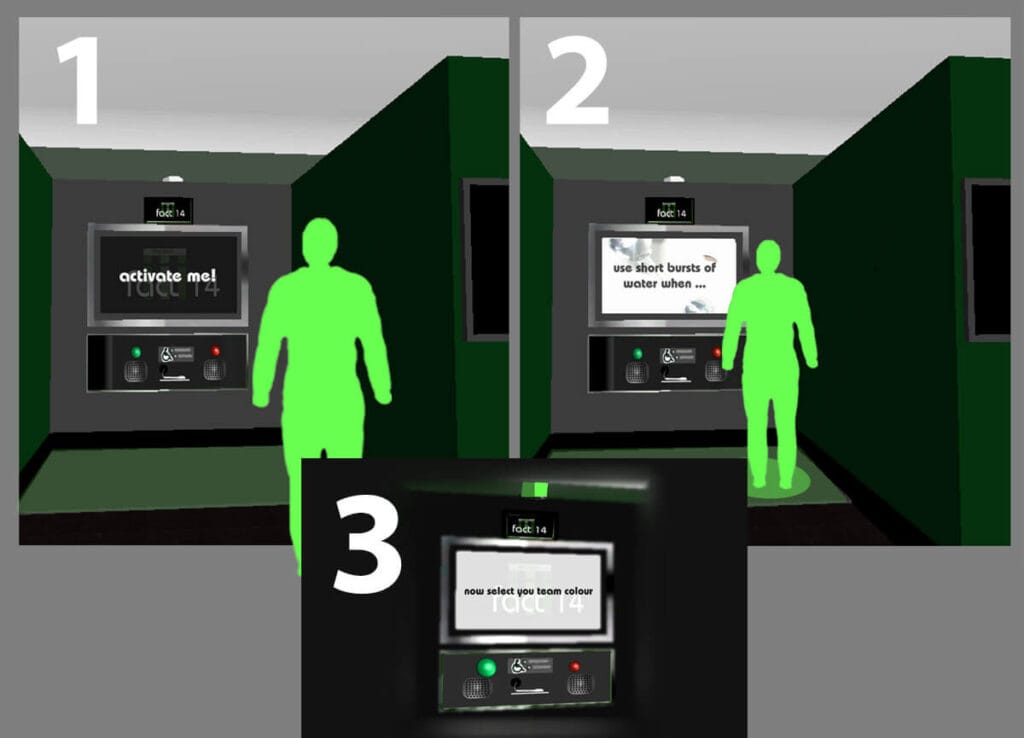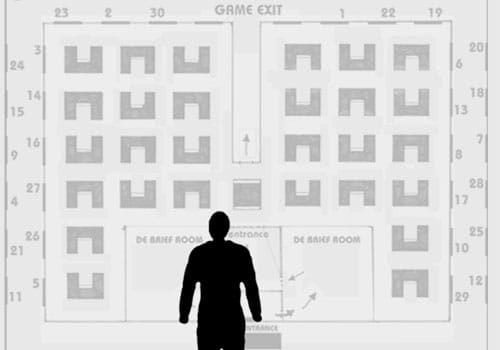Today we all know how climate change is a worldwide issue, but how much do we implement these facts into our life? This social interaction changes that.
Client: Public Installations / Museums / Schools Location: England, UK Challenge: To create an installation that would make environmental facts stick in people's mind so they would be more likely to act on them
The Background
The Mazer Interaction was a social innovation project that aimed to help people become more aware of the facts of climate change. This project was 15 years ago now (and one of the first interactive installations I led), but it’s added as the message is still as relevant as ever, if not more so.
The brief for the team I was working on this with was to develop a solution that would make people interact with facts (‘interfacts’). There’s always been a lot of information and warning about climate change but very little seems to truly change someone’s consciousness more than when you get them interacting and implementing something they learn.
With this in mind, we went about our research into how we could cement facts into people’s minds more. I remembered an age-old truth about design psychology, ‘it takes around 8 times to repeat something before someone truly brings it into their consciousness’. There’s a reason we see adverts repeated on TV so many times.

I wanted to develop a solution that would somehow get people/users to play with facts in an interesting way, to make facts less boring or forced upon them. I tried to bring choice architecture into play.
The Solution/s
This particular project was an art installation popup that could have the potential to be toured around the country and put up in town halls or other concrete venues with public space.
The idea was to demonstrate how facts could be easily ingrained into our minds once they become fun to remember, and therefore I proposed creating an interactive game that would work a bit like a maze and a bit like laser quest.
I named it the Mazer (maze and laser) Interaction.
The idea was to have two opposing teams working against each other to gain as many facts as possible by finding them in a ‘maze’ of different ‘fact stations’ (popup structures that would each house a separate fact within them – each with a central screen to display the fact).
In the proposal, there were two possibilities, the simple approach or the more complex approach.
The simple approach simply had one screen on each ‘fact station’ popup. A user would simply press a button to play the visual fact and then select a colour button (red or green) based on your team’s colours. At the end of the fact, you would be given another fact station number to go and find in the maze (with each fact station having a different number and randomly placed around in the maze).

The aim was to find as many facts as possible within the time limit, but also try to overturn the opposing team’s facts – if a fact station was lit up red and you were on the green team you could press to play that fact again to turn it to green (and they could do the same to you). You would have to listen and view the whole fact ‘video’ (which were short) before you could turn it to your colour.
The idea was to force repetition in a fun way, and the team who had the most fact stations lit up in their colour when the time was over would win. Players would leave knowing many more facts about the environment as they would’ve subconsciously taken them in over and over again.
The more complex approach (which we opted against in the end for budget reasons), was to treat fact stations each as their own ‘puzzle room’ (inspiration was led from the Eureka Museum in Halifax where people interact and learn about the human body in a fun way, but for adults too).
Team members would have to go into the room and use a clue to work out a solution based on that fact, with the room’s style/theme designed around that fact, and then come out of the room and go to the screen to turn the fact to their colour before moving on to the next fact station the screen told them to go (randomly).

Alternative Concepts
Another concept idea was to make all the walls like a 3D video that would show you video footage of the potential effects of not trying to solve a facts particular issue (such as the effect of wasting too much water etc).
There were suggestions of making this an online app game (which we later did for another topic), and also for the inside fact station area to go one step further and be used as a VR experience around the facts.
We ended up implementing a ‘third team’ idea. Around the outside of the maze there were family members waiting for team players, but instead of passively waiting they too could get involved and interact in the game by watching facts from outside and turning an internal fact station into a white light (where neither green nor red would then have it lit in their colour and have to go back to light it again).

This ‘third wheel’ element proved to be really interesting and added a new dimension to the experience, extending the social reach.
The Further Challenges & Environmental Touch
With every conceptual idea, we had to be aware of both feasibility and viability. Could it be done within budget and space constraints? Would it become a sustainable example of how installations of the future could be done? And more importantly, would the environmental awareness message get across?
As a social innovation, the concept had to be a place where users would want to spread the word, but while the interactiveness would appeal to children and young adults, we also were aware of how adults needed to change their habits.
There were a fair few challenges to consider.
Firstly, we ensured the message wasn’t hypocritical. The materials we would use for the installation would be natural, eco-friendly and recyclable. They wouldn’t create waste and we would be resourceful in how they were used. The screen output would use minimum energy, and lights would be energy-efficient bulbed. We also toyed with the idea of having energy-generating bikes as part of the installation game.
With resourceful thinking, we developed easily foldable fact stations that could literally ‘pop up’ and then just be stationed with minimal padded scaffolding. This made the whole installation easy to mount and dismount and travel away to the next venue in the ‘eco bus’ (part of the Mazer Eco branding).
The Outcome
From follow up surveys after the first trial installation the feedback was generally very positive. We asked a few questions on which 3 facts they remembered most and people answered a whole array of different facts, which was promising. In response to whether the installation changed their daily outlook and actions 74% said they were now more actively switching lights off or walking more when they didn’t need to drive etc.
However, the installation lost funding after only 3 months, as do many non-profit installations, so the true extent of the impact of this installation would never be known (and as we can see today society has a habit of ignoring climate concerns until it’s too late, which is a great shame).
I’ve added this older project in hope that someone out there wants to revisit it and work on it with me, as with my vision and your determined interest we could hopefully help more people truly ‘act now’, or as the Mazer Interaction says ‘fACTs NOW’, as today it’s needed more than ever.
Contact me if you, or someone you know, would want to fund such a project, or work with me to find a scaled-down environmental solution instead.
A CASE STUDY FROM:


